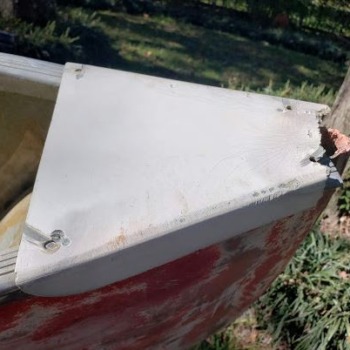
I can’t say I’m a huge fan of traditional marigolds. But this larger version with full, delicate foliage and large, showy blooms caught my attention. The seeds I bought were labeled “Alaska”, but are actually “African”.
I’ll admit that when I bought this seed, I expected a white or off-white marigold because that what the photo online portrayed. Instead, the flower is definitely lemon-yellow. The plant itself easily is almost two feet tall with large 3 inch blossoms, so I’ll forgive the yellow color. The seeds didn’t arrive until August, but I took a chance and planted them anyway. So glad, because they sprouted in a few days, bloomed in a few weeks, and were the only flowers still alive and blooming in the yard after a hard frost in mid-November. This plant is definitely a prolific bloomer even in high temperatures and little rain.
Now into my second season of growing them, I’ve learned a few things:
- Transplant them deeper, up to 50% of the stalk. Like tomatoes, planting more of the stalk encourages a better root structure to support the top-heavy foliage.
- The plant has to be encouraged to branch out. Pinch when they are about 8 inches in height, otherwise it will become a tall, lanky plant.
- Spray them with rabbit repellent if bunnies are a problem. Apparently their foliage is delicious.
- Once established, they are very drought resistant, disease resistant, and heat tolerant.
- Harvest the seeds as soon as the blossom head turns brown, but before the stalk beneath the blossom turns brown.
- Mature stalks will root up in water in days – literally in only a few days. Green stalks take a little longer to root.
Growing
These seeds sprout quickly and are very tolerant of being transplanted. About 1/3 of the sprouts would get trapped/strangled by the seed hull, so planting them at least 1/8 inch beneath soil is best to keep the hull very moist until the seed is fully sprouted. Transplant them into a larger pot as soon at the first set of true leaves develop. Because they get so tall and top heavy when mature, transplant as much of the young stalk beneath soil level as possible. When the plant is about 8 inches tall, pinch off the top to encourage branching.
Harvesting Seeds
Because this plant is such a prolific bloomer, harvesting seeds is very easy. But I noticed that if I waited to harvest seeds until the stalk beneath the flower head turned brown, there would actually be seeds already sprouting inside the flower head. So now I harvest as soon as the flower head is brown.
Peel open the flower head beginning at the base, extract the black seeds and leave them out to dry for a day before sealing them up in a ziplock bag.
Propagation
African Marigold cuttings root up very quickly. Young, green stems take as little as 5-6 days to begin rooting. But once the stalk begins to take on a brownish-red tone, the marigold will root up within a matter of days. This is a great way to not only have beautiful flower cuttings in your house for a week or two, but also to have a large rooted cutting to plant back into your garden afterward.
I don’t actually take any cuttings. After a heavy rain storm or high winds, heavy branches of the marigold tend to break off. Rabbits will also cut down several plants in order to nibble on the tender foliage. What I found was that it doesn’t matter what length the “cutting” was, it always roots up. The darker, more mature stems rooted up quicker than the tender green stems.
No rooting hormone was needed. Roots on mature stems would develop within 2-3 days and roots on green stems developed within 5-6 days. Once the roots were roughly 2 inches long, pot them up and give them a week of attention/extra water before transplanting them back outside.








